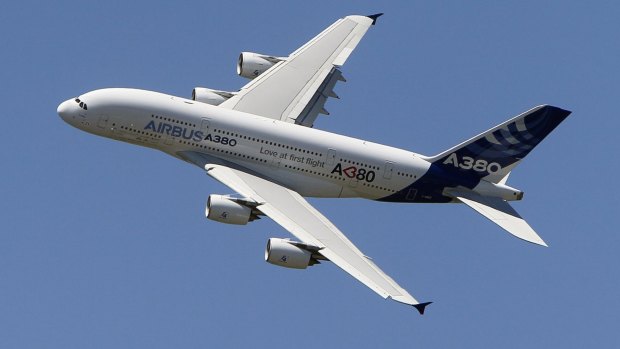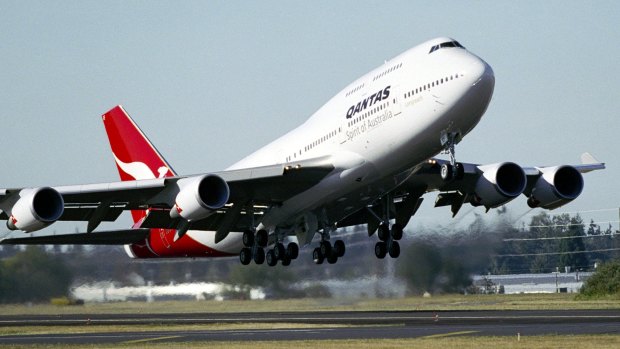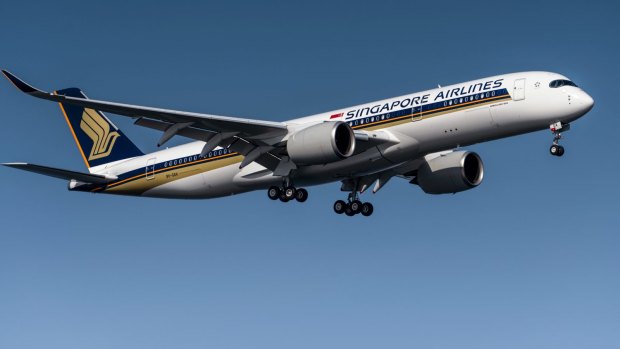This was published 5 years ago
Boeing 747s and Airbus A380s: What the end of four-engine planes means for passengers

Airbus will stop production of the A380 superjumbo, the world's largest passenger aircraft, in 2021.Credit: AP
January 22, 2020 marks the 50th anniversary of the first commercial flight by a Boeing 747. On that day, the first jumbo jet took off with fare-paying passengers on a flight from New York to London.
It was a day late – the Pan Am flight was scheduled to depart on the evening of 21 January but engine overheating grounded the aircraft. Another 747 was called into service instead with a delay of several hours. Despite that initial hiccup, over the past half century the Boeing 747 has proven its worth, and then some.
It was a different world back then. In 1970 John Gorton was our PM and Richard Nixon sat in the White House. Australia's population was half what it is today, you watched television in black-and-white, for the first time you could buy a digital electronic watch and your parents might have been tootling around town in a Holden Premier.

Qantas will retire all its 747 jumbo jets by the end of this year.Credit: Qantas
All have passed into the pages of history, yet after several permutations the Boeing 747 is still alive and well. Since the first 747 took off Boeing has delivered more than 1500 of the aircraft and over 500 were still in service in December 2019, but that's coming to an end. Boeing is no longer producing the 747 as a passenger aircraft. Its superjumbo competitor, the Airbus A380, made its commercial debut in 2007 yet Airbus will cease production of the aircraft in 2021, a casualty of falling orders. Qantas will make its final 747 flight by the end of this year. The era of big double-decker four-engine aircraft is grinding to a halt.
Traditionally the 747 and A380 have been the workhorses of long-haul routes – although Japan Airlines used a 747 on some of its Tokyo-Osaka flights, with a flight time of just 1 hour 20 minutes. These days, airlines looking for aircraft that can transport large numbers of passengers at competitive cost and capable of flying long distances are signing up for either Airbus' A350 or Boeing's 787 Dreamliner, with Boeing's 777X expected to enter service in 2021. What does this mean for air travel?
Safety

The twin-engine Airbus A350-900ULR currently flies the world's longest route, Singapore to New York non-stop.
Many flyers love flying aboard a four-engine aircraft because they need only one functioning engine to remain airborne, and with four engines – what could possibly go wrong? Actually, from time to time things have gone badly wrong.
Such as when a British Airways 747 en route from Kuala Lumpur to Perth flew through a cloud of volcanic ash over Indonesia and all four engines died. They restarted when the aircraft descended and some of the ash was dislodged from the engines, otherwise the crew was prepared for a water landing, never before attempted in a jumbo.
Do twin-engine aircraft have a slimmer safety margin than their four-engine counterparts?
Especially when aircraft are operating on long overwater routes far from airports where they could make an emergency landing, aren't four engines better? Such as flight QF63, the Sydney-Johannesburg route that Qantas operates using a Boeing 747-400. At times during the flight the aircraft will be thousands of kilometres from any airport to which it could divert in an emergency, so surely a four-engine aircraft makes better sense?
Not according to regulators who certify an aircraft's Extended-range Twin-engine Operational Performance Standards (ETOPS for short). The ETOPS rating of an aircraft is the flight time in minutes that aircraft is certified to operate from the nearest airport suitable for an emergency landing. In jocular pilot-speak, the ETOPS acronym is sometimes referred to as "Engines Turn Or Passengers Swim".
Sydney to Santiago, Chile requires an ETOPS of 330 minutes. Sydney to Rio de Janeiro, if such a flight were to happen, would require an ETOPS of 370 minutes. The same applies to east coast Australia to Cape Town, although for the existing Qantas service between Sydney and Johannesburg the required ETOPS is 330 minutes.
Some of the latest twin-engine aircraft have an ETOPS rating equal to or greater than the four-engine giants. The Boeing 787 Dreamliner has an ETOPS-330 rating, which is what allowed LAN Airlines to replace the four-engine Airbus A340 on its Santiago-Auckland-Sydney service with the Boeing 787 (a flight the airline recently started doing non-stop, skipping Auckland). The Airbus A350XWB was the first aircraft to win an ETOPS-370 rating. By comparison, the first four-engine aircraft to be given an ETOPS-330 rating was Boeing's 747-8, in 2015.
According to Boeing's latest Annual Statistical Summary of Commercial Jet Airplane Accidents, the A380, Boeing 787, Boeing 747-8 and Airbus A350 all have a fatality-free record.
Range
As airlines contemplate ever more ambitious long-distance routes you can expect those to happen aboard twin-engine aircraft. Although there's not a great difference between the range of the four-engine jumbos and the leading twin-engine widebody aircraft, when airlines are looking for the longest legged aircraft to service their furthest routes the twin-engine aircraft ace the deck.
Singapore Airlines uses an Airbus A350-900ULR for its Singapore-New York service, currently the world's longest non-stop flight.
See: Hour by hour: My epic trip on board the world's longest flight
Qantas has chosen the Airbus A350-1000 for its proposed non-stop flights from Australia's east coast to New York and London, which will take the longest-flight trophy from Singapore Airlines if it happens. Sydney to New York is 16,200 kilometres, to London is a shade over 17,000 kilometres.
That will require the aircraft to be fitted with extra fuel tanks. Airbus developed the A350-900ULR specifically to suit the needs of Singapore Airlines in order to operate its Singapore-New York flights, so they could do something similar for Qantas. Qantas also uses a Boeing 787 Dreamliner for its Perth-London flights, which sits in third on the table of world's longest flight routes
See also: On board the epic non-stop Qantas flight from London
Not too far behind, Emirates currently uses an A380-800 for its 14,200-kilometre Dubai-Auckland flight, the longest scheduled flight aboard a four-engine aircraft, but Qatar Airways uses a twin-engine Boeing 777-200LR for its slightly longer flights from Doha to Auckland.
Passenger Comfort
Flyers love the roomy dimensions and smooth and stately ride of the four-engine jumbos, the A380 in particular, but for those in economy it doesn't matter too much whether you're squished into a seat aboard a four-engine or twin-engine aircraft. One advantage of flying aboard the 787 Dreamliner and Airbus A350 is higher cabin pressure, which means more oxygen in the air you breathe and higher humidity, which should add up to a more comfortable flight with less fatigue. The airframes of these aircraft make extensive use of carbon fibre, which is not subject to structural fatigue to the same extent as a traditional all-metal fuselage, and therefore capable of tolerating greater cabin pressure.
Will you miss the era of the four-engine airliner as they fade away? Post your comments below.
See also: Death of the A380: Airline to ditch entire superjumbo fleet
See also: Boeing's new, giant plane could change flying forever
Sign up for the Traveller newsletter
The latest travel news, tips and inspiration delivered to your inbox. Sign up now.